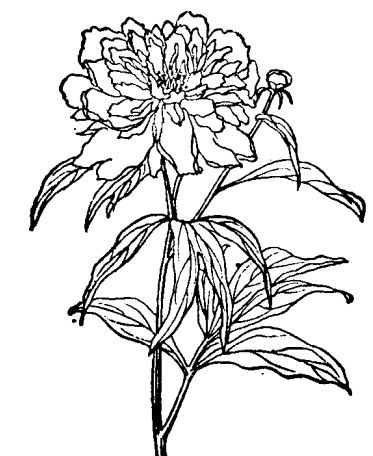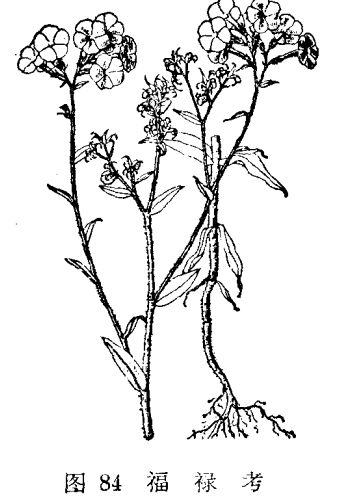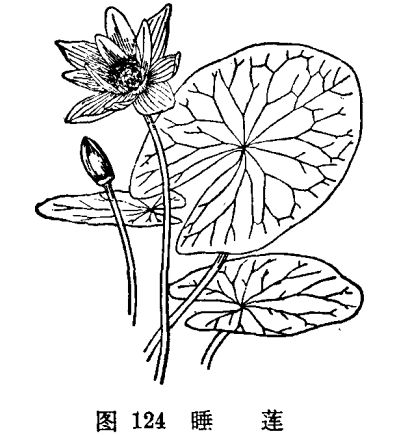Propagation methods and methods of Paeonia lactiflora
Paeonia lactiflora is mainly propagated by individual plants, and it can also be sown.
1. Split-plant method: this method can maintain the excellent characteristics of the variety, and the flowering date is earlier than that of the sower. The ramet of Paeonia lactiflora must be carried out in autumn, usually from late September to early October, when the ramet can restore root growth for a period of time before winter and produce new roots, which is beneficial to the growth of the following year. This is the reason why Chinese florists have a proverb that "the Spring Equinox divides the peony and does not blossom until he is old". The method of ramet is to dig up the root plant, shake off the soil, and then separate it along the place where nature has been separated, otherwise split it with a knife so that each clump has 3-5 buds. In medicinal cultivation, the thick root is usually cut off and processed into medicine at the neck of the root at the bottom of 5murm 6cm, and then the root cluster is planted. (this article is from the Encyclopedia of Agriculture)
The ramet years of Paeonia lactiflora vary with different cultivation purposes. when planted in flower beds or cut flowers, the ramets will be divided after 6-7 years, and when the medicinal cultivation is for the purpose of picking roots, they will be planted once every 3-5 years.
2. Sowing method: sowing propagation is generally only used to breed new varieties, or to cultivate peony rootstock. After the seeds of Paeonia lactiflora are mature, they should be sown immediately, and the later the seeds are sown, the lower the germination rate will be. After sowing, it took root in the autumn of that year, and the new buds were unearthed after the warmth of the next spring. The seedlings of Paeonia lactiflora grew slowly, only 2 leaves were produced in the first year, and grew faster in the second year. The well-developed ones could blossom in 4-5 years.
[cultivation] Paeonia lactiflora has deep roots and should be ploughed deeply and fully applied with basic fertilizer, such as rotten compost, stable manure, oil meal and bone meal, etc. The planting depth should not be too deep or too shallow. Generally, the thickness of the soil overlying the bud should be about 3murmur4cm, and the soil cover should be moderately suppressed at the same time.

Paeonia lactiflora is fond of fertile soil. In addition to applying sufficient organic fertilizer during planting, topdressing is applied once before and after flowering in spring, and attention should be paid to the combination of the three elements of fertilizer; depending on the fertility of the soil in autumn and winter, some late-acting fertilizers can be applied.
Peony likes moist soil, when planted in flower beds, it can not be irrigated if it is not too dry, but it must be kept moist before flowering before it can bloom beautifully.
In addition to the apical bud, there are 4 lateral buds under the peony before flowering, which are usually removed after the appearance of the lateral buds, so that the nutrients are concentrated in the apical buds and produce larger flowers. For varieties that are easy to lodge during flowering, pillars should be set up.
There are many diseases of peony, and the main diseases are the same as those of peony.
Propagation methods of Paeonia lactiflora
Paeonia lactiflora is very popular with people, and many flower friends will raise several peony flowers at home. Today, I will share with you the breeding methods and points for attention of peony.
Propagation methods of Paeonia lactiflora
Paeonia lactiflora is generally propagated by individual plants. As the saying goes, "the Spring Equinox divides the peony and does not blossom when he is old." Therefore, Paeonia lactiflora is not suitable for transplanting in spring, and it is usually divided after the aboveground part withered in October. But in fact, there are generally two methods of propagation of Paeonia lactiflora, one is sewing breeding, the other is sowing and breeding.
The best ramet time is from late September to early October, when the aboveground part of Paeonia lactiflora has stopped growing, and the rhizome is the most nutritious. After ramet planting, the root system still has a period of time to restore growth, which is beneficial to the growth of the whole plant in the coming year. First dig out the roots of the mother plant, shake them off the soil and hang them for a day, then separate the roots along the natural separation of the peony, and cut them with a sharp knife, each with four to five buds. The root incision had better be coated with sulfur powder to prevent the invasion of bacteria, and then dry for another day or two. Open-field planting of peony, plant spacing of 50 cm, row spacing of 70 cm, potted peony, flowerpot caliber and depth of 40 cm is more suitable. Paeonia lactiflora should be divided into plants once every five to six years, and peony that is mainly collected should be divided once every three to five years.
Points for attention in the reproduction of Paeonia lactiflora
Paeonia lactiflora can not be transplanted frequently after planting, otherwise it will damage the root and affect the growth and flowering. In order to make the peony grow well, reasonable fertilization is needed every year. The first application was in March, the second in April, the third in late May, the fourth after the End of Heat in late August, and the fifth in November. After each fertilization, enough water should be irrigated, and the soil should be loosened immediately to reduce water evaporation, and weeding should be often ploughed in the rainy season.
More information on how to propagate Paeonia lactiflora, and how to reproduce Paeonia lactiflora
The cultivation of Paeonia lactiflora is mainly based on the traditional propagation method, which can be planted by ramet, sowing, cutting, striping and other methods, of which the split method is the most easy and widely used. Let's take a look at the details:
Propagation methods of Paeonia lactiflora
I. split-plant method
The method of plant division is the most commonly used propagation method of Paeonia lactiflora, which is basically used in the production of seedlings in peony producing areas. It has three advantages: first, it blossoms earlier than sowing method, sowing seedlings blossom in 4 ~ 5 years, and ramet seedlings can blossom every other year; second, ramet operation is simple and easy to operate, labor-saving management is conducive to wide application; third, it can maintain the excellent characters of the original varieties. The disadvantage is that the reproduction coefficient is low, and the three-year-old mother plant can only be divided into 3-5 offspring, so it is difficult to adapt to and meet the needs of modern large-scale production and the rapid growth of domestic and foreign flower markets.
1. Ramet time
Theoretically speaking, the ramet of Paeonia lactiflora can be carried out from overwintering bud filling in real time to before land freezing. However, when planted at the right time, the ground temperature is still high, which is beneficial to the healing of root wounds, sprout new roots, enhance the ability of cold and drought tolerance, and lay the foundation for the germination and growth of the following year.
Do not divide plants too early, so as to avoid the occurrence of autumn phenomenon and affect the growth and development of the following year; nor should it be too late, when the ground temperature can no longer meet the needs of peony roots, resulting in poor growth of new plants in the following year. If the plants are planted and the buds sprout as late as spring, the root system is injured due to higher air temperature, low air temperature and large transpiration in spring, which can not absorb water and nutrients normally, resulting in very weak growth and even death. Therefore, the Chinese agricultural proverb has the saying that the Spring Equinox divides peony and does not blossom when he is old.
The suitable period for the ramet of peony is generally earlier than that of peony. Heze's agricultural proverb "July peony, August peony (refers to the lunar month)" means that in Heze, peony can be divided from the end of August until late September (the End of Heat to the Autumn Equinox). The ramets in Yangzhou were from late September to early November. Ramet seedlings can split again after three or four years of growth. For a long time, the root system will decay, the plant growth will be weak, and the flowering will be poor.
two。 Ramet method
When ramet, carefully dig up the fleshy root, reduce the root injury as far as possible, after digging up, remove the persistent soil, cut off the old hard and decayed places, and split each plant with 3-5 sub-plants, each with 3-5 or 2-3 buds; when the mother plant is small and the planting task is large, each sub-plant can also take 1 bud, but the growth should be restored more slowly, and the thick root should be retained when ramet. If the soil is moist, the root of paeony is crisp and easy to fold, it can be hung for a day before it is divided, and then slightly dried in the shade and dipped in the mud containing nutrients.
In the garden green space, peony has been planted for many years, and its growth is weakening and urgent to be planted, but it can not be watched by visitors during flowering because of reproduction. The method of local ramet can be used to dig a deep hole next to the peony plant with a shovel to expose part of the peony root. Then, cut the peony plant with a shovel to reduce the vibration to the original plant as much as possible, take out the cut-off part and plant it. The deep hole dug can be compacted with appropriate amount of fertilizer and soil.
We can also use the method of interplanting or interplanting, so that the ramets can be rejuvenated without affecting the landscape, only for 2-3 years in a row. However, because the continuous cropping of peony is avoided, the method of interplanting can not be applied continuously, otherwise the occurrence of diseases and insect pests is serious, the growth is poor, and even the mortality rate is greatly increased.
When Paeonia lactiflora is used for medicinal cultivation, the peony head is often used to propagate in the peony producing area, and the mother plant is dug up in autumn, all the coarse roots are cut off for medicinal use, and the peony head with bud is used as propagation material. First of all, remove the peony head without buds and diseased feet, cut the peony head into blocks, each piece with strong buds 2-3, peony head thickness 2 cm, too thick main root is not strong, multi-bifurcated, too thin is lack of nutrients. It is best to cut along with the planting, if not in time, do not cut, the head of peony can be stored in sand. It is suitable to be planted from early August to late September.
3. Post-ramet management
The planting depth is about 2 cm in the soil, too deep is not conducive to germination, and easy to cause rotten roots, leaves yellowing, poor growth, too shallow is not conducive to flowering, and easy to suffer frost damage, and even the rhizome exposed to the ground, hot summer sun exposure, resulting in death. If the ramet root cluster is large (with 3-5 buds), there may be flowers in the second year, but the shape is small, so it is better to remove to make the plant grow well. Roots from small (2-3 buds), poor growth or no flowering in the second year, usually cultured for 2-5 years.
2. Cutting method
Select a high-lying, well-drained nursery as a cutting bed, after the bed soil is loosened, spread 15 cm thick river sand, and the river sand should be disinfected with 0.5% potassium permanganate. The cutting substrate can also be vermiculite or perlite. Build a 1.5-meter-high sunshade on the bed. According to the experience of Changchun and other places, the effect of cutting cuttings in mid-July is the best. The cuttings are 10-15 cm long.
With two nodes, the last compound leaf, leaving a little leaf; the next compound leaf, even petiole cut off, with a concentration of 500 × 10 ~ 1000 × 10 naphthalene acetic acid or indole acetic acid solution quickly dipped in cuttings, cutting depth of about 5 cm, the spacing between leaves do not overlap each other. Pour water after insertion, and then cover the plastic shed. It is observed that the rooting effect is the best when the substrate temperature is 2830 ℃ and the humidity is 50%. If the temperature is 20: 25 ℃ and the humidity is 80% 90% in the cutting shed, it can take root and form dormant buds 20-30 days after cutting. After taking root, the amount of water spraying and watering should be reduced, and the plastic shed and sunshade should be removed gradually. The cuttings grow slowly and need to be covered with soil on the bed to survive the winter, and then moved to the open field for planting the following spring.
3. Root insertion
The roots of Paeonia lactiflora were cut off in autumn and cut into 5-10 cm root segments, which were inserted into deep-turned and flat ditches with a depth of 10-15 cm, covered with fine soil 5-10 cm thick, and watered thoroughly.
- Prev

The main producing areas and planting methods of Fulukao
[alias] oleander, plum blossom, Platycodon grandiflorum. [families and genera] Carpinaceae, Phlox. Annual herbs, plant height 15-45 cm. Stem erect, much branched, with glandular hairs. Basal leaves opposite, others occasionally alternate, broadly ovate, rectangular orbicular to lanceolate. Cymes terminal
- Next

How do water lilies reproduce? what are the breeding methods?
Water lilies are mainly propagated by ramets, usually after defrosting in spring. First dig the exuberant underground stem from the pond mud, select the section with new buds, and cut it into 6 Murray 10 cm long underground stem, which is used as the mother seed for ramet propagation, and then planted flat in the mud, but not too deep.
Related
- Fuxing push coffee new agricultural production and marketing class: lack of small-scale processing plants
- Jujube rice field leisure farm deep ploughing Yilan for five years to create a space for organic food and play
- Nongyu Farm-A trial of organic papaya for brave women with advanced technology
- Four points for attention in the prevention and control of diseases and insect pests of edible fungi
- How to add nutrient solution to Edible Fungi
- Is there any good way to control edible fungus mites?
- Open Inoculation Technology of Edible Fungi
- Is there any clever way to use fertilizer for edible fungus in winter?
- What agents are used to kill the pathogens of edible fungi in the mushroom shed?
- Rapid drying of Edible Fungi

